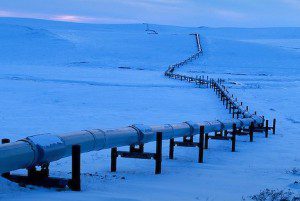Almost all oil production on Alaska’s North Slope remains shut down after workers on the Trans-Alaska Pipeline system discovered a leak over the weekend. BP, the pipeline company’s largest single owner, has called it a significant event.

BP is no stranger to pipeline problems in Alaska. We recently reported that a BP maintenance report in October found severe corrosion throughout its own system of pipelines, and workers had complained of “Band-Aid” solutions to long-running maintenance issues.
At the time, BP spokesman Steve Rinehart told us that the company has an aggressive and comprehensive pipeline inspection and maintenance program, and the 148 pipelines ranked “F” for corrosion were not necessarily a current safety risk. We will not operate equipment or facilities that we believe are unsafe, he said.
BP’s listing of corroded pipes and its documentation of pipeline failures wouldn’t have included the Trans-Alaska Pipeline, which is operated by Alyeska Pipeline Service–technically a separate company. But as we’ve noted, Alyeska is largely controlled by BP, which owns 47 percent of the company. Other owners include ConocoPhillips, Exxon Mobil, Unocal Pipeline, and Koch Alaska Pipeline.
With the exception of the company’s current CEO, Alyeska has always taken its top talent on loan from one if its oil company owners, and only once has its CEO come from a company that’s not BP, noted AlaskaDispatch. Alyeska’s current CEO, Thomas Barrett, took his post on January 1, exactly one week before the most recent spill was detected.
The pipeline system has had a long history of maintenance problems and worker safety complaints. Here’s what we reported in November:
In 2006, two spills from corroded pipes in Alaska placed the company’s maintenance problems in the national spotlight. At the time, BP temporarily shut down transmission of a portion of its oil from its Prudhoe Bay field to the continental United States, cutting off approximately 4 percent of the nation’s domestic oil supply, while it examined its pipeline system.
Photographs taken by employees in the Prudhoe Bay drilling field this summer, and viewed by ProPublica, show sagging and rusted pipelines, some dipping in gentle U-shapes into pools of water and others sinking deeply into thawing permafrost. Marc Kovac, a BP mechanic and welder, said some of the pipes have hundreds of patches on them and that BP’s efforts to rehabilitate the lines were not funded well enough to keep up with their rate of decline.
Several more close calls on Alaskan pipelines came between September 2008 and November 2009, when three BP gas and oil pipelines on Alaska’s North Slope ruptured or clogged, as we’ve reported.
Prior to this weekend’s incident, the most recent closure of the Trans-Alaska Pipeline occurred in May, during the BP oil spill, when several thousand barrels of oil spilled from the 800-mile line.
by Marian Wang
ProPublica


